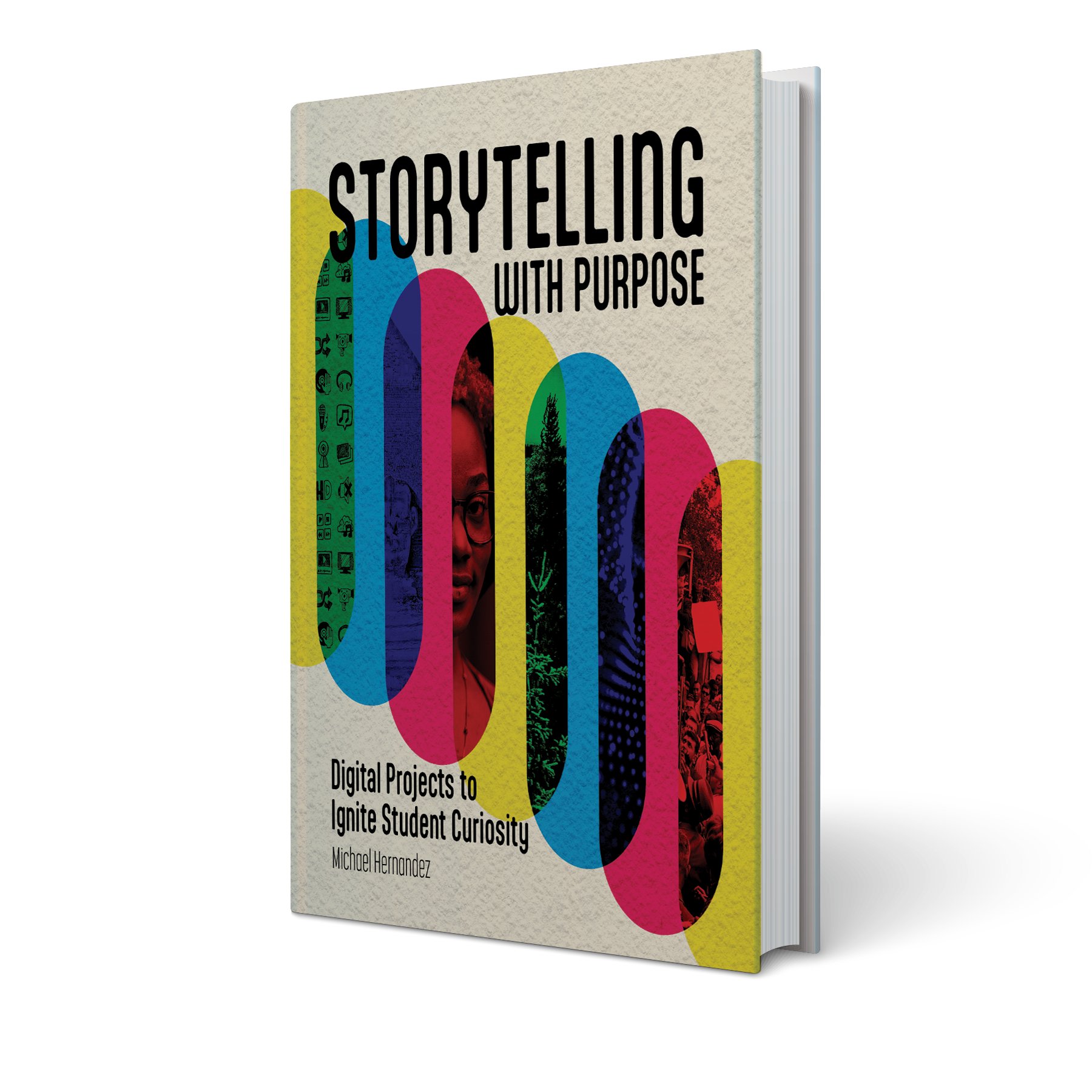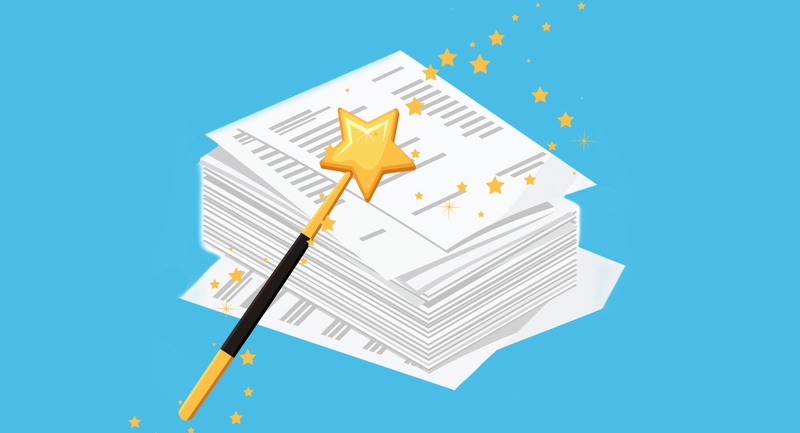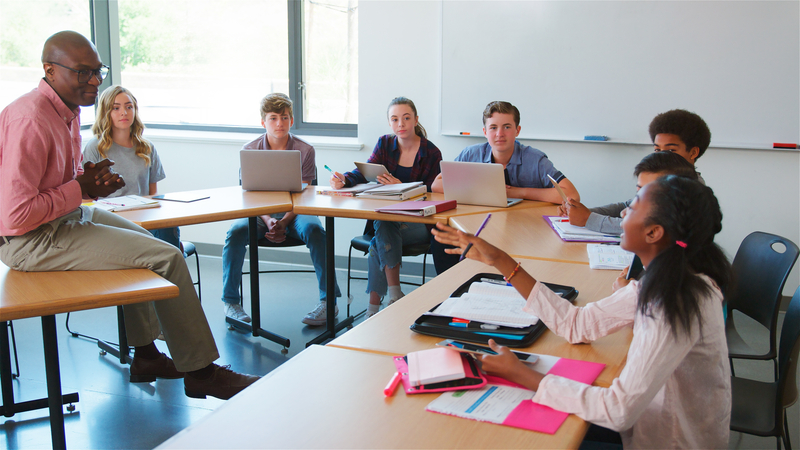In my 25 years of teaching, I’ve learned that kids want to engage with the world and make an impact. That’s especially true of the world we live in right now, which can be a confusing and complicated place. Students (and teachers, for that matter) also want to have fun, enjoy learning, and be part of something meaningful.
Digital storytelling projects—like those I’ve used with my students—can help teachers connect the curriculum to their communities, and help students make connections across disciplines and to their own lives. At a time when artificial intelligence has everyone wondering about the future of writing instruction, digital storytelling projects like those outlined here and discussed in my forthcoming book, Storytelling With Purpose: Digital Projects to Ignite Student Curiosity (ISTE, 2024), provide highly engaging, authentic learning experiences and “uncheatable” assessments.
Empowering our students to become resilient, curious, and literate citizens has always been what teaching is about. Digital storytelling helps develop these skills, energize classrooms, and provide purpose in the curriculum. Rather than being an add-on to our workload, digital storytelling projects can be a simple way to amplify what teachers already do best, and help students see the joy and purpose of learning—in every grade level and subject area.
What Is Digital Storytelling?
Digital stories are more than just videos—they encompass a broad range of multimedia formats and tools that allow students to communicate ideas effectively to an audience. These can include photographs, digital books, audio recordings and podcasts, data visualizations and infographics, editorial illustrations and graphic novels, and video documentaries. Platforms like websites and social media add an element of interactivity, allowing audiences to comment, like, and reshare; zoom in and out; rewind, replay, or skip; and generally “choose-their-own-adventure.” This is a much more dynamic way for audiences to relate to student content and for students to gain valuable feedback from people other than their teacher.
While writing still forms the foundation of all nonfiction digital stories (through research, interview questions, scripts, captions, titles, etc.), digital stories provide a dynamic way for students to connect with the subject matter.
Student-created digital stories provide opportunities for multimodal learning and flexibility in how students relate to curriculum and show what they know. Examples include (as shown above)
a video PSA, marked-up images, and a digital book.
As educators, we ask students to tell stories of their learning all the time through essays, lab reports, presentations, discussions, and performances. Digital story projects enhance these experiences by embedding purpose and relevance into the curriculum (especially when publishing for an authentic audience).
Researchers have found that students exposed to greater variation at the time of learning were significantly more capable of recognizing broader concept applications (Di Vesta & Peverly, 1984). This means that the multimodal experience of creating digital stories is more than just fun and engaging—it’s good pedagogy.
One of my favorite story projects, the explainer video, is a perfect example of multimodal learning. These short videos, created with presentation apps like Keynote or Google Slides, allow students to explain a topic, define terms, or show a process through various types of media such as images, sound, video, text, and voice-over. The ability to publish these explainers publicly provides greater meaning for our students, too, since they know their work will be seen by others beyond the classroom and have the potential to make an impact.
These kinds of projects are also more inclusive and equitable than traditional assignments. Unlike an essay or report, explainers allow students to choose how they show their learning. Students who are language learners or have learning disabilities may struggle with written assignments, for example, and shy or socially challenged students may stumble in class presentations, speeches, or Socratic seminars. But digital storytelling empowers them to leverage their strengths.
The Benefits of Digital Storytelling
When I work with teachers at workshops and conferences, I often get the sense that digital stories are perceived as nice-to-have projects that we give to students once their “real” work is done. But when we use digital storytelling as a framework for learning, it can help us solve some of the biggest challenges we face in education right now, including digital literacy, student engagement, and equitable assessment.
Digital storytelling accomplishes several things:
It redefines literacy. Digital storytelling embraces a more encompassing definition of literacy, one that reflects the many ways we create and consume content in a digital-first world (NAMLE, 2020). Historically, educators have used the term “literacy” to mean the ability to read and write text. But as our world becomes increasingly complex and connected by digital media, literacy can be more accurately defined as: competency in the ways we explore and understand the world, how we express ideas, and most important, how we relate to one another. This includes understanding and creating visuals (Bobek & Tversky, 2016), using and managing digital platforms in professional contexts (not just for play), demonstrating civic responsibility and engagement, developing cultural literacy, and exhibiting the ability to understand and empathize with people from different backgrounds.
More than simply decoding words, phrases, or numbers, literacy is about understanding and communicating context—how facts, events, politics, and people relate to one another, and how we relate to them as participants in a complex and interconnected society.
Digital storytelling is a rigorous experience that enhances and strengthens learning in every subject area. Researchers have found that creating visual explanations is an effective way to learn science (Bobek et al., 2016), and that project-based learning improves achievement in social studies (Summers & Dickinson, 2012) and language arts (Miller & Pennycuff, 2008). Even Advanced Placement students score better when they have experience with project-based curriculum like story projects (Saavedra et al., 2021).
It emphasizes authenticity. We’ve all been through professional development that is disconnected from our work or asked by administrators to complete tasks that seem to go nowhere. In the same way, our students are often assigned work that only ends up in the trash, or at best, displayed in the classroom for a few weeks. This sends a strong message that their work doesn’t matter, and that their effort is in vain.
To motivate our students to care about their learning, we need to make our assignments useful; we need to give them a greater purpose beyond the confines of our classroom walls. Digital storytelling projects incentivize students to produce high-quality work because students know that, upon completion, their projects will be displayed publicly or used by others.
It discourages cheating. The problem of cheating, which has always been a struggle for educators, has been exacerbated by digital tools like ChatGPT and other forms of artificial intelligence. Addressing this problem requires us to consider why students are motivated to cheat and also to reflect on why our assessments are so “cheatable” in the first place. How authentic are they, really?
In my journalism class, students create news stories—a kind of multimedia research project—that tackle real issues in our community. Each story begins with the student’s curiosity and wonder about the world, and the process of answering their initial question becomes a personal quest. The goal of this learning experience is to produce a final product—a digital story—to help solve problems, draw attention to the needs of underrepresented groups, and relay reliable facts so that their audience can make good decisions. In a sense, journalism is like STEM for the humanities, since it creates a product (the story) for an end user (the audience) that strives to solve a problem (understanding of a topic).
For example, a recent story produced by one of my students addressed an intersection in our community where drivers consistently ran stop signs. Once the story was published on our YouTube and Instagram accounts, local police took notice and placed an officer at the intersection to issue tickets. Who knows whose life was saved or bodily injury avoided because of this student’s work.
How do I grade a project like this, particularly in relation to other student projects that may have been easier to complete or less impactful? If I adhered to a rubric about the technical quality of the video footage (it had several flaws) or the performance of the student’s voice-over script (it was good, but not amazing or particularly original), he might have received a B+. But the sum is greater than the parts with story projects, especially given the fact that this one educated and motivated a government agency to act. A number or letter grade cannot accurately measure this kind of learning outcome.
My role as a teacher, then, should be less of a scorekeeper and more of an accountability partner, encouraging students and playing devil’s advocate to their decision making. Direct instruction is kept to a minimum, and I mostly serve to facilitate good question-asking, ensure ethical conduct, provide feedback, and offer technical help and logistical support. When I finally do have to give grades, I measure values rather than systems: to what extent have stories been courageous, generous, and professional?
In examples like the “intersection” project, curiosity and purpose drive the learning, not the threat of grades. In this case, my student set a goal to make a difference by solving what he thought was a real problem through learning and sharing knowledge. And for these reasons, he had no motivation to cheat.
Research tells us that curiosity, like the kind fostered by storytelling projects, is critical for learning (Kidd & Hayden, 2015). And the one-of-a-kind learning artifact produced through the storytelling process ensures that no one else—not even ChatGPT—can do the work for students.
Storytelling as a Way of Thinking
We often think of stories as the end product—an infographic, digital book, or podcast. But in the classroom, creating digital stories is an effective way to scaffold learning. To be successful in their learning quests (completing an effective digital story they are passionate about), students learn and apply the knowledge, skills, and mindsets central to our curriculum along the way. They now see the curriculum as an important tool to help them achieve their goals, rather than a set of dry, tedious assignments that we as educators want them to accomplish.
The process of creating story projects helps students develop the mindset and workflow they need to thrive in the future.
In my journalism, cinematic arts, and photography classes, I find that the hardest part of the process can be deciding what story to tell. Students must think critically about who or what to include and what gets left out. They have to find accurate information (research) and wrestle with how to present ideas clearly, with special attention to the impact their work might have on others. All of these steps require deep thinking, historical and political context, and good ethical decision making.
Digital stories also activate critical thinking by allowing students to determine the best medium or combination of media to convey their ideas most clearly to others. Consider, for example, how much clearer a data visualization chart or graph is than a spreadsheet of raw numbers, or how much clearer a map is than a list of written directions. Ever want to learn how to carve a turkey or refinish furniture? Think about how much harder it’d be to read a set of instructions than watch a YouTube video.
Similar to language arts and STEM classes where students often workshop their projects, producing digital stories requires students to go through the process of giving and receiving feedback and revising their work. This helps them gain perspective and see learning as a collaborative endeavor rather than an individualistic, competitive one. In my classes, we often use a design thinking framework to move through cycles of ideation, iteration, testing, and revision.
So, while the concepts, facts, and skills from our curriculum remain important, the process of creating story projects helps students develop the mindset and workflow they need to thrive in the future. This includes learning how to ask good questions, fostering healthy collaborative relationships, discovering how to give and receive feedback, understanding the importance of context, and most important, embracing wonder and curiosity as a strength.
Quick-Win Digital Storytelling Projects
Story projects shouldn’t be an add-on to your existing workload, but simply a pivot from assignments you already have. Some story projects, like explainer videos, can be a direct replacement for essays or class presentations; others, like oral history projects (podcasts) or digital books, might have a slight learning curve. While there are many ideas for story projects in my book, here are a few quick-win projects you can try right away.
Annotated Photography
Researchers have found that creating visual explanations of information improves learning (Bobek et al., 2016). Have students use their smartphones or tablets to take photos of phenomena from your curriculum, then use markup tools to digitally label or comment on specific details. This might be parts of a sentence or paragraph in language arts classes, solutions from math, results of a science lab, or maps and charts in social studies. Level up: Have students also record audio descriptions and explanations, then curate content created by one or more students into a class digital book. Challenge more experienced students to take on this editing and curation task themselves.
Skills learned:
Interview an Expert
Using the audio recorder app on phones or tablets, or video conferencing tools like Zoom, have students interview an expert on a topic they’re currently learning about. Then have students create a written self-reflection of the experience in a Google Doc or a blog post on a website, and include a recording of the interview for reference. Level up: Have students create a podcast by editing the interviews and adding voice-over commentary and music.
Skills learned:
Public speaking and interpersonal skills
Question development
Qualitative research methods
Scheduling meetings
Importance of primary sources and expertise
Anthology Projects
Websites and digital books give students a repository to collect multiple learning artifacts such as essays, photographs, audio recordings, data visualizations, or videos. This helps students create larger narratives that can make space for complex topics, provide opportunities for collaborative stories with multiple authors, or show progress and change of a topic over time.
Anthology projects can be used for many purposes, such as portfolios of student work, lab reports, and literary magazines. These kinds of projects can also provide transparency about student learning journeys that you can share with parents, administration, colleges, or future employers.
Skills learned:
Editing and curation
Analysis
Writing
Collaboration
Human-Centered Experiences
Using nonfiction storytelling as a framework for learning embraces the idea that learning should be an authentic experience, both in the academic sense of conducting research and developing ideas, as well as in the motivational sense of creating an original product that will have an impact on an audience beyond the classroom. When we reimagine learning and success as human-centered experiences rather than data-driven processes, we can honor and support student independence, ownership, and personal responsibility, and foster a classroom culture of respect.
Tips for Incorporating Digital Stories in Your Classroom
Start small. Take a single assignment, like a report or presentation, and turn it into a digital storytelling project by having students produce an explainer video or podcast instead.
Keep stories short (a 1–3-page book or 60-second video, for example).
Use what you’ve got. Smartphones and tablets have built-in cameras and microphones, and graphics apps like Canva or Adobe Express can be downloaded on any device.
Honor the medium and know the limits of what it can convey. In the same way a movie version of a novel is different from the original book, so too are digital stories from their traditional writing equivalents. Dial back expectations of how much content students can cover in a single story project.
Storytelling With Purpose
Reimagine learning with this book’s practical advice, case studies, and strategies on using digital storytelling as a vehicle for student inquiry and assessment.










